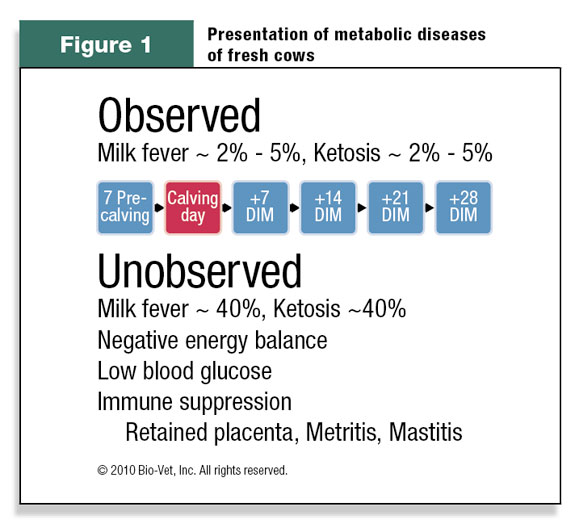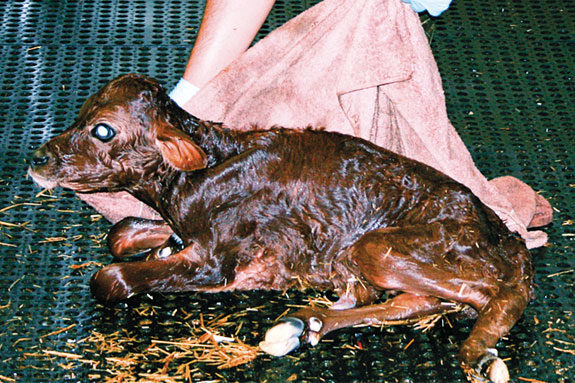In a previous article, we reviewed the fact that hypocalcemia (milk fever) and ketosis are by far the two most important diseases to consider for early-lactation cows. I consider these to be “iceberg diseases,” meaning that we only see the tip of the iceberg (typically about 2 to 5 percent of all dairy cows that calve exhibit clinical symptoms for each disease). See Figure 1 below left. On the other hand, various research studies show, on average, the subclinical rates of these two diseases may average about 40 percent each in today’s dairy cows.

This large discrepancy makes designation as clinical or subclinical irrelevant, because the vast amount of undiagnosed cases costs dairy producers dearly.
Estimates of the economic impact of fresh cow metabolic disorders vary widely.
When evaluating both clinical and subclinical impacts at typical rates reported by numerous studies for fresh cow/metabolic diseases (displaced abomasum, retained placenta, metritis, dystocia or difficult birth, milk fever and ketosis), average treatment and lost production costs could easily range from $100 to $400 for each cow that calves in the U.S.
Hypocalcemia (milk fever)
Subclinical hypocalcemia can induce the same secondary disease problems (reduced immune function, increased risk of mastitis and metritis) as clinical milk fever and reduce the health and productivity of a cow.
In research conducted for the USDA’s NAHMS Dairy 2002 study, subclinical hypocalcemia was defined as serum calcium less than 8.0 mg/dl of blood. Subclinical hypocalcemia increased with advancing age and was found at the following rates. (See Table 1 below right.)

In recent years, hypocalcemia has mainly been prevented by manipulating the dietary cation-anion difference (DCAD) to decrease the blood pH of cows during the late prepartum and early postpartum period.
The DCAD approach provides an excess of anions over cations in the diet by adjusting ration components, adding anionic salts to the ration or both.
Drawbacks to this approach include strict monitoring of urine pH to assure effectiveness of DCAD and palatability of anionic salts.
Ketosis
Cases of ketosis in very early lactation are part of a spectrum of conditions associated with intense fat mobilization in cattle, and may be associated with fatty liver.
Blood levels of non-esterified fatty acids (NEFA) or β-hydroxybutyric acid (BHBA) are the most accurate methods of diagnosis. NEFA may be more reliable pre-calving and BHBA more reliable post-calving.
All dairy cows in early lactation (first six weeks) suffer negativeenergy balance and are at risk of ketosis. The clinical incidence in lactation in individual herds varies substantially. Ketosis occurs in all parities.
Lactating cows with subclinical ketosis (i.e. serum BHBA concentrations >12 mg/dl) are at increased risk of developing clinical ketosis, compared with cows with lower serum BHBA concentrations. Incidence of subclinical ketosis in lactating cows may be 40 percent or higher.
Of equal importance is the duration of the ketotic state in cows. Prolonged states of ketosis have a more profound effect on poor reproductive performance and reduce immune system function. Early-lactation cows may be ketotic for only a few days or for several weeks.
Diagnosing ketosis in a herd is usually done by sampling enough representative cows at risk for ketosis (5 to 50 days in milk), and then evaluating the proportion of cows above the commonly used cut-off point for BHBA.
This tells us the prevalence of ketosis on this particular date. Garrett Oetzel, DVM, MS (Univ. of Wisconsin) suggests using 10 percent as the alarm level for herd-based ketosis testing. Ketosis incidence is significantly higher than prevalence due to the duration of ketosis.
According to a 2009 Cornell University study concerning metabolic diseases of interest (DAs, clinical ketosis, metritis and/or RPs), the BHBA critical threshold was 10 mg/dl. The critical threshold is the level at which risk of disease becomes significantly different.
For example, experiencing elevated metabolite levels postpartum increased the risk of a DA by up to 10 times and contributed the greatest risk for disease development in general. This study also showed animals with elevated metabolite levels took longer to get pregnant, and there was strong evidence of significant ME305 milk loss.
Earlier data from University of Wisconsin researchers showed lactating cows with blood BHBA concentrations above the cut-off point of 14.4 mg/dl were at threefold greater risk to develop DAs or clinical ketosis.
Data from University of Guelph researchers showed cows with blood BHBA levels above 10 to 14 mg/dl had significantly lower pregnancy rates and that the negative effect on pregnancy was nearly linear with a 2 to 3 percent decrease in pregnancy rate for each 1 mg/dl increase in BHBA starting at zero.
These studies illustrate that any level of subclinical ketosis can have negative impacts on cow health, production and reproduction. This impact does not just become significant at one level of BHBA or NEFA.
To help alleviate the effects of subclinical hypocalcemia and ketosis on cows, I recommend products that contain readily available calcium (chloride and propionate forms), high levels of antioxidant vitamins (A and E), chelated trace minerals and that produce or supply glucose precursors (propionate, propylene glycol).
Supplements that increase propionate yield from rumen fermentation can also be very beneficial for managing ketosis. These include select propionate-producing microbial supplements.
Some feed additives, including niacin, calcium propionate, sodium propionate, propylene glycol and rumen-protected choline, may be beneficial in managing ketosis. To be effective, these supplements should be fed in the last two to three weeks of the dry period, as well as during the period of ketosis susceptibility after calving.
Supplements containing yeast or live microbials help support rumen function and appetite, which in turn improves energy balance.
Types of products containing the above ingredients that fit well into standard fresh cow protocols include:
• Low-volume and high-volume drenches
• Pastes and gels
• Capsules and boluses
• Direct-fed microbials fed daily
Today’s dairy producers should review all such products on the market to determine which best fit their individual operations. Some products or methods fall in and out of favor over the years, and there may be an improved formula or delivery method available for producers to consider. PD
Zimmer is also president of Bio-Vet Inc, based out of Blue Mounds, Wisconsin.
References omitted due to space but are available upon request to editor@progressivedairy.com .
PHOTO
When evaluating both clinical and subclinical impacts at typical rates reported by numerous studies for fresh cow / metabolic diseases (displaced abomasum, retained placenta, metritis, dystocia or difficult birth, milk fever and ketosis), average treatment and lost production costs could easily range from $100 to $400 for each cow that calves in the U.S. Photo by PD staff.

William Zimmer
Veterinarian
Bio-Vet Inc.
bill.zimmer@bio-vet.com







